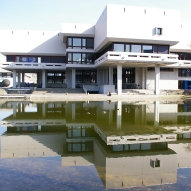Zusammenfassung
Objective: Arteriogenesis, describing the process of collateral artery growth, is activated by fluid shear stress (FSS). Since this vascular mechanotransduction may involve microRNAs (miRNAs), we investigated the FSS-induced expression of vascular cell miRNAs and their functional impact on collateral artery growth during arteriogenesis. Approach and Results: To this end, rats underwent femoral ...
Zusammenfassung
Objective: Arteriogenesis, describing the process of collateral artery growth, is activated by fluid shear stress (FSS). Since this vascular mechanotransduction may involve microRNAs (miRNAs), we investigated the FSS-induced expression of vascular cell miRNAs and their functional impact on collateral artery growth during arteriogenesis. Approach and Results: To this end, rats underwent femoral artery ligation and arteriovenous anastomosis to increase collateral blood flow to maximize FSS and trigger collateral vessel remodeling. Five days after surgery, a miRNA expression profile was obtained from collateral tissue, and upregulation of 4 miRNAs (miR-24-3p, miR-143-3p, miR-146a-5p, and miR-195-5p) was verified by quantitative polymerase chain reaction. Knockdown of miRNAs at the same time of the surgery in an in vivo mouse ligation and recovery model demonstrated that inhibition of miR-143-3p only severely impaired blood flow recovery due to decreased arteriogenesis. In situ hybridization revealed distinct localization of miR-143-3p in the vessel wall of growing collateral arteries predominantly in smooth muscle cells. To investigate the mechanotransduction of FSS leading to the increased miR-143-3p expression, cultured endothelial cells were exposed to FSS. This provoked the expression and release of TGF-beta (transforming growth factor-beta), which increased the expression of miR-143-3p in smooth muscle cells in the presence of SRF (serum response factor) and myocardin. COL5A2 (collagen type V-alpha 2)-a target gene of miR-143-3p predicted by in silico analysis-was found to be downregulated in growing collaterals. Conclusions: These results indicate that the increased miR-143-3p expression in response to FSS might contribute to the reorganization of the extracellular matrix, which is important for vascular remodeling processes, by inhibiting collagen V-alpha 2 biosynthesis.






 Altmetric
Altmetric